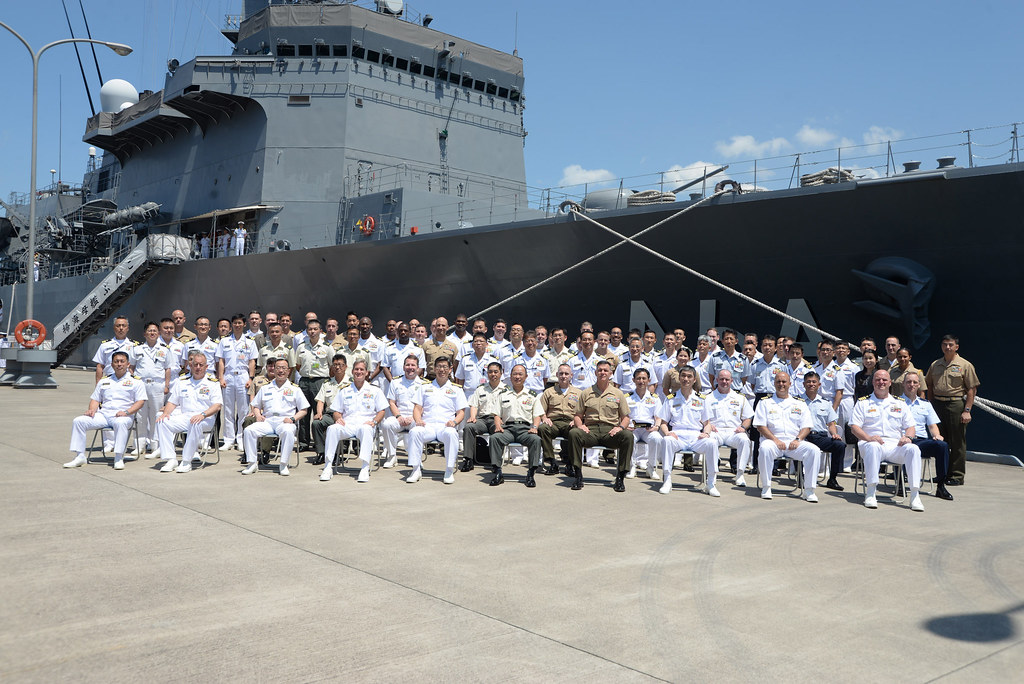By Lt. Adam Cole, Amphibious Force 7th Fleet Public Affairs
Participants of the U.S.-Japan bilateral amphibious and mine warfare staff talks pose for a group photo in front of JS Bungo (MST 464). (U.S. Navy/LT Adam Cole) >>
KURE, Japan - U.S. military and Japan Self Defense Force personnel comprising 34 different commands across ground, maritime, and air services met for bilateral amphibious and mine warfare discussions, May 22-24.
The staff talks were hosted by Japan Maritime Self Defense Force’s Mine Warfare Command, Japan’s counterpart to the U.S. Navy’s Amphibious Force 7th Fleet.
This year marked the 14th time these two staffs have met to maintain and enhance the bilateral partnership as well as dialogue on increasing integration for training and operations. Beginning last year, the talks were opened up to include landing force counterparts from U.S. Marine Corps and Japan Ground Self Defense force units. This year, the participation was extended even further to include Air Force and Japan Air Self Defense Force personnel.
Given the multitude of entities represented, the focus of this year’s talks was joint capability: maximizing synergy between air, ground, and maritime assets and personnel. Participants outlined future bilateral opportunities and training goals that will further tactical operations and interoperability in both amphibious and mine warfare, leveraging joint capabilities.
“We are grateful for Japan and the Mine Warfare Force staff hosting us this year,” said Rear Adm. Marc Dalton, commander, Amphibious Force 7th Fleet. “These talks ensure our two forces have common appreciation of each other’s capabilities, procedures, and vision for amphibious and mine warfare, but also an established plan for training and improving together in the future. We look forward deepening this partnership that is a central part our two nation’s longstanding alliance, which in turn is critical component of regional stability.”
Topics of the staff talks included command and control, air space management, and training certification, in addition to analyzing upcoming opportunities for bilateral exchange.
Those in attendance felt the talks were valuable and recognized that enhancing the U.S.-Japan alliance was predicated on investing in relationships between forces.
“The strength of this alliance is built on relationships,” said Brig. Gen. John Jansen, commanding general, 3d Marine Expeditionary Brigade. “Those gathered at this year’s staff talks personify what a meaningful relationships between allies looks like. Over the last year, we’ve been together during the command post exercise Yama Sakura in Okinawa and operated side-by-side at sea aboard JS Hyuga during Keen Sword—we’ve spent a lot of time together.”
Jansen added that through relationships the end result is stability in the region.
“These relationships are the kind we need to demonstrate strength to ensure ‘peace through strength’ that will lead to peace and stability to the region,” he said.
Participants also had the opportunity to tour the Japan Maritime Self Defense Force LCAC facility, the Maritime Officer Candidate School and the Naval History Museum.
Participating commands included the Japan Joint Staff, Air Defense Command, Western Army, Amphibious Rapid Deployment Prep Uni, Self Defense Fleet, III MEF, 31st Marine Expeditionary Unit, Amphibious Squadron 11, 3d Marine Expeditionary Brigade, and Naval Beach Unit 7.
Commander, Amphibious Force U.S. 7th Fleet is the Navy's only forward-deployed amphibious force, headquartered at White Beach Naval Facility, Okinawa.

